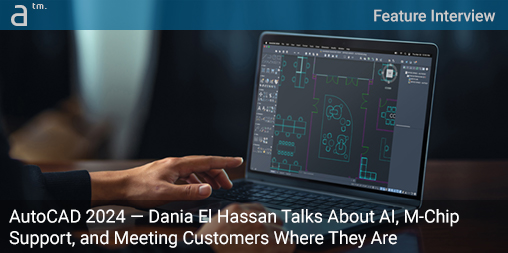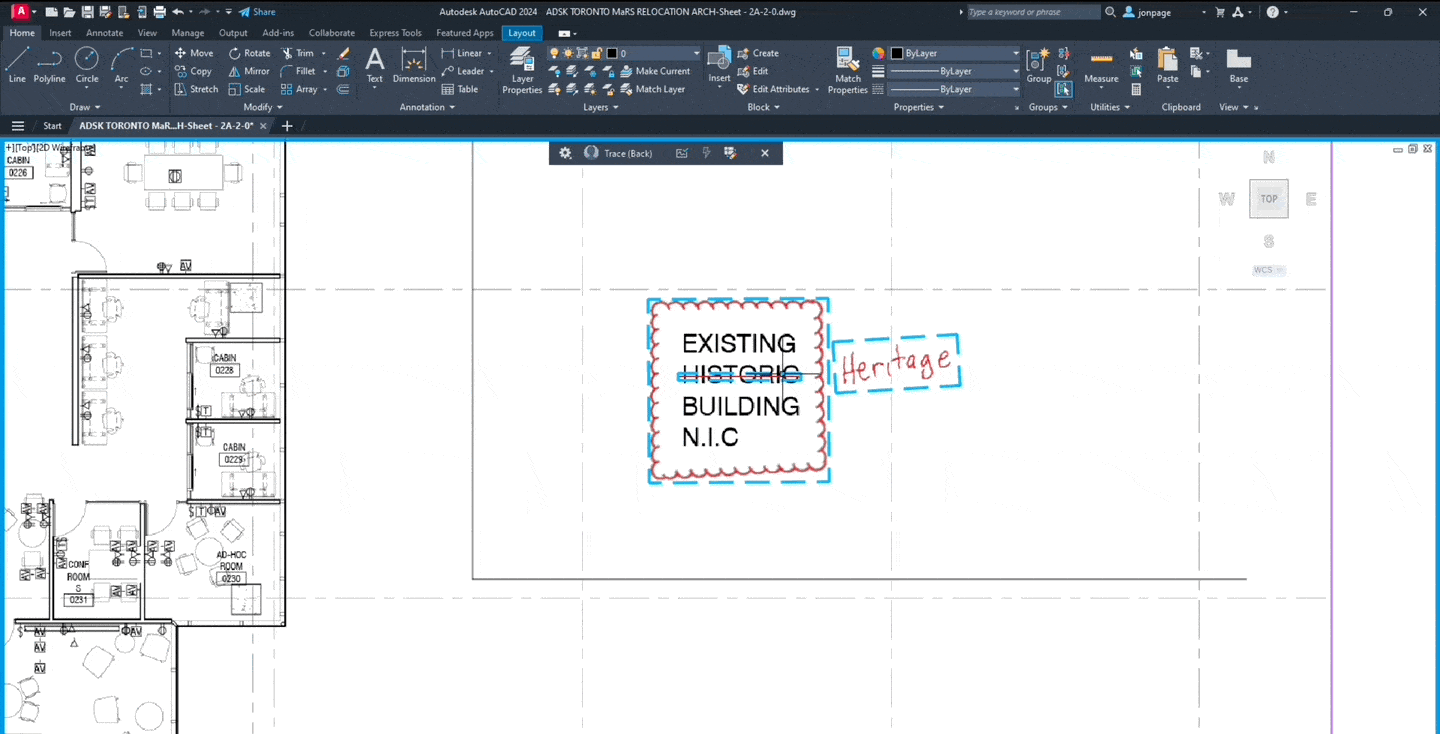AUTOCAD 2024, IN ITS VARIOUS versions, has recently been released. After a discussion with Dania El Hassan, Director of Product Management for AutoCAD, it is clear that Autodesk is pushing to discover new ways AI technologies like machine learning (ML) can help bring productivity gains for its users.
NVIDIA CEO Jensen Huang at GTC 2023 noted this year in AI’s iPhone moment. Given the mainstream media’s new attention to AI across numerous domains and, especially, OpenAI’s ChatGPT tools, it looks likely that Huang is correct. Our coverage here at Architosh—and especially our Xpresso newsletter—is increasingly focused on AI developments.
AI is everywhere. But machine learning algorithms need data.
Smart ML Requires Data
In order to make meaningful advancements with AI (artificial intelligence), a software company must obtain lots of excellent data on how software systems are actually used.
Dania El Hassan noted that their Insights program helps them learn what customers are actually doing in AutoCAD instead of what customers say they are doing. “The two can actually be very different,” she reports.
The company has an abundant array of inflows for customer feedback, all feeding into Autodesk’s organized data pool from which strategic AI technology planning occurs. El Hassan notes that the data inflows include the Autodesk Community, Autodesk Customer Council, AU (Autodesk University), aggregate data from external trade associations, Autodesk’s customer success and Product Support teams, and the relatively new Autodesk Customer Advisory Board.
When you open up AutoCAD for Mac 2024 and just start using it as you would, you will feel this snappiness that is just lovely.
“We are also doing some other things too, specifically dedicated efforts around research in automation and machine learning,” says El Hassan. “We began around 2018 or so and are trying to understand where lies the greatest opportunities for automation, specifically for AI but also for performance.”
In the latest release, AutoCAD 2024 delivers several increased uses of AI and machine learning—everything from more intelligence and ML-based assistance around AutoCAD Blocks to smarter Markup Assist features to save users time. And the new Activity Insights features allow teams to get notifications on file changes, look at who edited the file in the past, who plotted the file, or shared the DWG with others, including its Xrefs.
Performance Boosters
And speaking of time, Autodesk has been re-engineering many of its core software engines for years, as underlying chip architectures and graphics pipeline technologies have been making substantial changes. For example, AutoCAD for Mac 2024 (including the LT version) is now a Mac Universal code base, meaning it runs fully natively on Apple Silicon (M1, M2, and future M-series processors)
While the news of up to 2x performance sound extremely lofty if applied to the whole application, El Hassan clarifies: “The M-series chips offer some capabilities that if you code to them, specifically, you will experience some of these performance enhancements.”

An image of AutoCAD 2024 running on an Apple MacBook with full native Apple Silicon support. General performance is 2x faster than running AutoCAD 2023 under Rosetta on M-chip-based Mac computers.
El Hassan notes that the M-chips don’t just yield 2x AutoCAD performance compared to Intel parts inside a Mac. “We did an additional level of work where the DWG drawing itself and how the AutoCAD engine reacts to that drawing works well with the M-series chips. “When you open up AutoCAD for Mac 2024 and just start using it as you would, you will feel this snappiness that is just lovely. It feels like it just gets out of your way.”
The new Mac versions also use the latest versions of Apple’s Metal API for the graphics pipelines. Additionally, Autodesk improved the performance of moving from one tab to another when a user has multiple DWG files open across tabs. According to El Hassan, this is common with many civil engineers and others.
MORE: AutoCAD for Mac 2024—New Release Boast Native M-Chip Support
“This is largely a low-level 2D graphics improvement where we updated and optimized the way we look up viewports to accommodate larger and more complex drawings that we see in our customer’s projects today,” she says. “It’s also worth noting that we’ve made significant performance improvements this year, including Pan/Zoom.”
Other performance improvements beyond Pan/Zoom tab switching, including Save, Quit, and Install. “In the past few years, we’ve improved 2D and 3D graphics improvements by over 10x,” she says.
Collaboration and DWG
AutoCAD’s Trace feature set also gained new advancements in version 2024 releases. El Hassan noted that the way AutoCAD processes, say, handwritten markup on the Trace layer is via machine learning (ML) pixel comparisons technology. “We have done a bit more than just use this available technology because CAD is a bit more complicated than regular pixel-based images,” Autodesk’s advancements in algorithms make ML smarter and more accurate.
The “fading” feature technology added this year means traces are controllable in terms of opacity by the user—plus, they can be put the Trace on top or under CAD layers—but individual markups on the Traces can fade away as the user processes those markups. “You can just fade items away and mark that as complete,” she says.
Our chat confirmed that AutoCAD Web—in at least the version with a full AutoCAD subscription—allows the user to create a new DWG from scratch. El Hassan noted that the separate AutoCAD Web subscription (which includes Mobile) is a low-cost and affordable way for a particular class of AutoCAD users who don’t need the robust performance of the desktop version or all its features for their basic tasks. For example, principals of architecture firms were cited as this kind of user.
One thing we are actually seeing is that AutoCAD is growing, Revit is growing, and the proportion of customers using both is growing.
“We really want to meet our customers where they are,” she says, meaning that the world of AutoCAD contains multi-decade users who grew up and only know that tool. In contrast, younger digital natives may be new additions to the platform and know many other tools (not just Autodesk ones).
Not Trailing-Edge Technology
In my talk with Dania El Hassan, I mentioned the term “trailing edge” as it is used in the semiconductor industry—referring to larger nanometer-based fabrication nodes instead of “leading edge” 3, 4, and 5-nanometer nodes. Our iPhones and Samsungs get the leading edge, while automobiles and IoT devices get the trailing edge. There’s a robust market for both!
In thinking about 2D CAD and AutoCAD, specifically, as this older technology that came before the BIM application Revit or tools like Fusion 360, it’s tempting to characterize AutoCAD as a “trailing edge” technology platform. But that would be a mischaracterization.
And the assumption that 2D CAD workflows in AutoCAD are “yesterday’s technology” and possibly in decline is equally false. “I love that you ask these questions,” says El Hassan. “One thing we are actually seeing is that AutoCAD is growing, Revit is growing, and the proportion of customers using both is growing.”
That growth likely reflects the industry’s trend toward targeted solutions and specialization. “So not only are customers still evolving to adopt Revit,” adds El Hassan, “they are adopting the latest AutoCAD workflows so they can use both side-by-side and capitalize on the best of both tools.”







Reader Comments
Comments for this story are closed